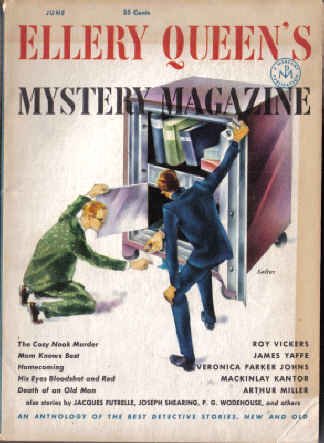Magazine Review: Ellery Queen’s Mystery Magazine June 1952 edited by Ellery Queen
This is the last issue of EQMM I have to hand, but someday I hope to get out to garage sales again….

“Homecoming” by Veronica Parker Johns was inspired, so the introduction says, by the Kefauver hearings and the author getting a much clearer picture of how despicable career criminals are. Mobster’s girlfriend Bebe has certainly learned this lesson now that she’s stuck hiding out on her old family farm with armed robber Max, with their only connection to the outside world being his partner Bat (who is most notable for making sure he never got photographed.) Max has become emotionally abusive and even more controlling, and murders a cat he’s worried might draw attention. Bebe realizes her only hope of escape is to get the police to take Max away, but how to get a message past him?
“Death of an Old Man” by Arthur Miller was written shortly after Death of a Salesman but is not as long. A police officer responds to a report of a death, and recalls that he met the deceased some years earlier when he was a rookie. He reflects on how he’s become more cynical since.
“Adrian Mulliner, Detective” by P.G. Wodehouse is a droll tale about a detective who is told that his dyspepsia is caused by ill humor, and he should smile more. The not exactly pleasant smile he manages to make strikes fear into the hearts of guilty aristocrats. (The British aristocracy, it turns out, are a cowardly and superstitious lot of criminals.)
“The Grinning God” by May Futrelle and “The House that Was” by Jacques Futrelle are a matched set of stories. Mrs. Futrelle was a popular author in her own right, but Jacques is more familiar to the mystery fan community thanks to his greatest creation, Professor Augustus S.F.X. van Dusen, the Thinking Machine. The pair had never collaborated, wanting to keep their careers separate, but when an editor saw an early draft of May’s story, he realized there had to be a rational explanation for its events, but could not for the life of him figure it out. So he begged Mr. Futrelle to lend his detective to the solution. And thus it’s the couple’s only collaboration.
“The Grinning God” tells a spooky tale of a man traveling by night who finds a fork in the road that should not exist, which leads to a house no one’s ever heard of, with strange, inexplicable inhabitants whose actions make no sense. When he tries to find the place the next day, he can’t; the only evidence that suggests he might not be mad is the title idol found in his pocket.
“The House that Was” has the Thinking Machine called upon to investigate the man’s story. While the explanation is still a little outlandish, it requires no supernatural events…and the center of the mystery is a “D’oh!” moment.
“His Eyes Bloodshot and Red” by Mackinlay Kantor is about a gangster who attempts to set up the perfect alibi for the murder of his twin brother. He makes one glaring mistake which he doesn’t realize until after he runs into the police. Kind of predictable, but fun.
“The Cosy Nook Murder” by Roy Vickers takes place in 1929. A stockbroker facing ruin after Black Tuesday is suddenly bailed out by a woman he hasn’t seen in years. Turns out that she’s had a torch for him all this time, and is under the delusion that he secretly reciprocates. He does not, and considers the prospect of being honor bound to repay her worse than death. Her death, anyway. He too, makes one fatal slip.
“Casanova’s Alibi” by Rafael Sabatini stars the historical figure in his early career. He’s in a Venetian prison for assault (which he totally did) when he comes up with a brilliant plan to prove that his accuser was lying (by doing more assault.) It works. How true the story is? (shrug)
“Mom Knows Best” by James Yaffe has a Jewish policeman visit his beloved mother, and over dinner she solves his latest case. A woman of negotiable virtue has been murdered, and the police can’t figure out which of three gentleman callers is responsible. Astute readers will figure it out before Mama spoonfeeds her son the answer.
“The Maggot” by Anthony Armstrong is a chiller about a murdered photographer. The solution’s pretty obvious, but the ending is ambiguous when it turns out a certain photograph may not have been tampered with.
“The Bishop of Hell” by Joseph Shearing takes place in the Eighteenth Century. Young rake Hector Greatrix is an all-round rotter who goes too far even for the decadent society he inhabits when he seduces his cousin’s wife and runs off with her to Italy. For his own safety, he cannot return to England and a duel of honor. Which would be fine, except that a series of deaths suddenly mean that he inherits a noble title and great wealth…but he can only fully access it by returning to England. It ends in tragedy–and either a nightmare or a true supernatural event. Content note: Obsolete language for a black woman.
“Papa’s Going Bye-Bye” by Kitty Harwood is a “First Story” from that author. A woman is terrorized by her husband and his large, scary dogs. Now he’s planning to blame her father for a death the husband caused by his own carelessness. But a well-trained dog doing exactly what it’s been told to do can work to her advantage as well. This closes the issue.
The Sabatini and Wodehouse stories are my favorites, but it’s a strong overall lineup. Most of these stories have been collected elsewhere if you want to look them up.

